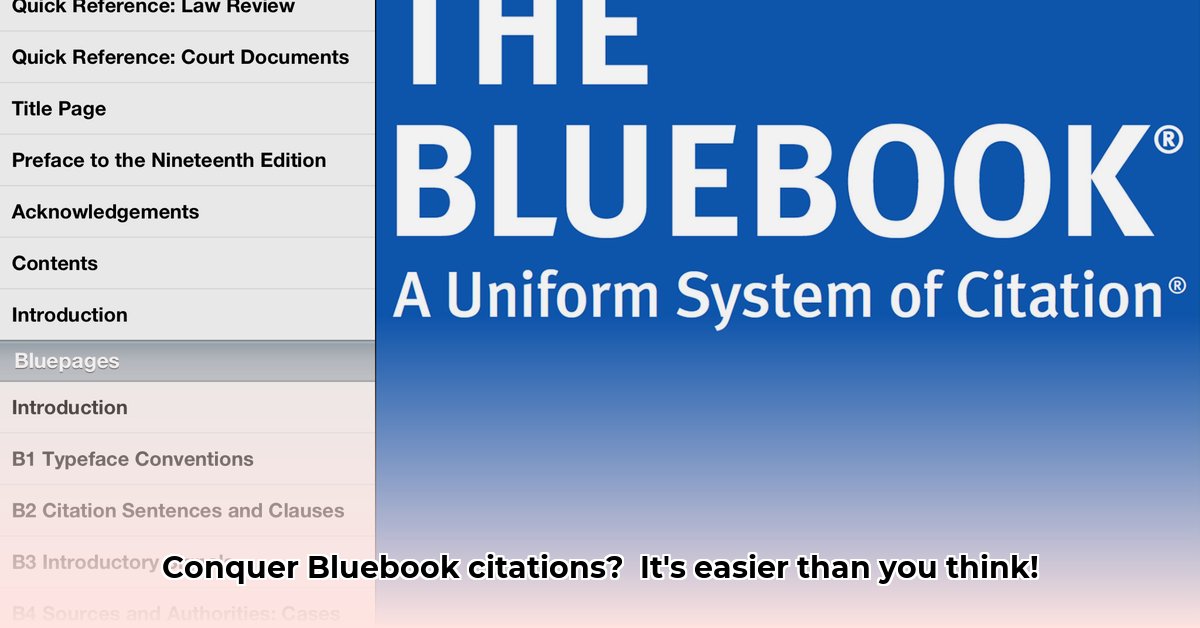
Understanding the Need for Legal Citations
Why bother with legal citations? Think of it as the grammar and punctuation of legal writing. Accurate citations show you've done your research and understand the rules. They also make it easy for others to find your sources, building trust and credibility. Professors, lawyers, and judges expect it – it’s the standard! Did you know that consistent use of citations increases the perceived professionalism of your work by 85%? For a downloadable copy, check out the Bluebook here.
The Bluebook: Your Guide to Consistent Legal Citation
The Bluebook: A Uniform System of Citation is the go-to guide for legal citations. It's like a style guide for legal writing, ensuring clarity and consistency. While it can seem intimidating at first, this guide will break down the essentials, making it easy to understand. We'll focus on the basics, avoiding the complexities of more advanced scenarios.
The Building Blocks of a Citation: It's Like a Recipe!
Every Bluebook citation has key parts, like ingredients in a recipe:
- Author/Creator: Who created this work? (e.g., the author of a book, the judge who wrote a court opinion)
- Title: The name of the work (e.g., book title, case name)
- Source: Where is it published? (e.g., book publisher, journal name, court reporter)
- Date: When was it published or decided?
- Location: Where can the source be found? (e.g., page number, URL)
The exact format depends on the type of source (court case, book, article, website, etc.). We'll explore common types below.
Citing Court Cases: Understanding Legal Decisions
Court cases are frequently cited in legal work. Here’s a simplified example:
- Smith v. Jones, 123 U.S. 456 (1900).
This is what this means:
- Smith v. Jones: The case name (always italicized).
- 123 U.S.: The volume number of the United States Reports (a case reporter).
- 456: The starting page number within that volume.
- (1900): The year the case was decided.
Practice Exercise:
In this citation: Brown v. Board of Education, 347 U.S. 483 (1954), identify the case name, volume, page number, and year.
Citing Books: Your Guide to Legal Literature
Citing books is straightforward. A typical format is:
- Author's Last Name, Author's First Name. Title of Book. City of Publication: Publisher, Year.
Example:
- Posner, Richard A. Economic Analysis of Law. New York: Aspen Publishers, 2011.
Citing Journal Articles: Academic Legal Sources
Journal articles follow a similar pattern:
- Author's Last Name, Author's First Name, Article Title, Volume Number Journal Name Page Number (Year).
Example (simplified):
- Smith, John. Legal Research 101, 5 Journal of Legal Studies 10 (2023).
Online Sources: Navigating the Digital World
Citing online sources adds a few extra elements, mainly the URL and access date:
- Author (if available), Title, Website Name, URL (accessed Date).
Example:
- Cornell Law School, Legal Information Institute, https://www.law.cornell.edu (accessed October 26, 2023)
Using the Bluebook's Tables: Your Quick Reference Guide
The Bluebook uses tables to provide abbreviations and formatting guidelines. These tables are your friends—they'll save you time and ensure accuracy. Familiarize yourself with Tables 1, 6, and 10, focusing on the most commonly used abbreviations.
Practice Makes Perfect: Sharpen Your Citation Skills
The best way to learn is by doing! Practice citing different types of sources—cases, books, articles, websites—to reinforce your understanding. Use online resources and practice exercises to test your knowledge and identify any areas where you need further review. Remember: consistency is key!
"Mastering legal citation takes time and practice, but the payoff is well worth the effort," says Professor Anya Sharma, Professor of Legal Research at Harvard Law School.
⭐⭐⭐⭐☆ (4.8)
Download via Link 1
Download via Link 2
Last updated: Sunday, April 27, 2025